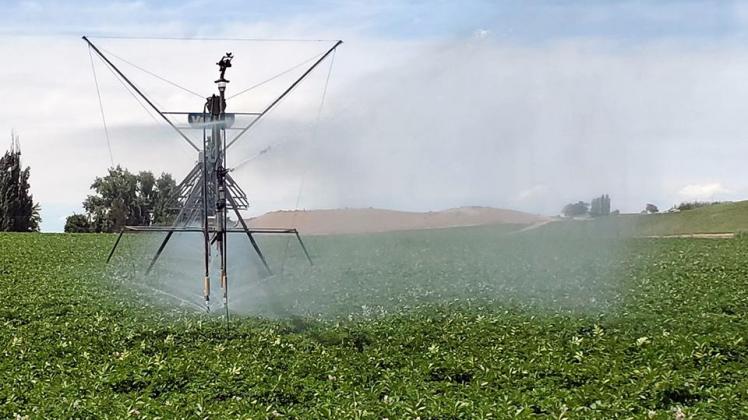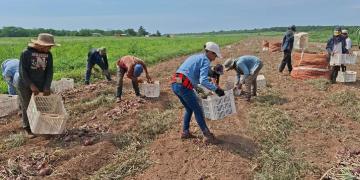EEUU: Protect Your Potato Crops During Heat Waves
Potatoes in the Columbia Basin of Washington average some of the highest yields in the world. Many aspects of the region’s climate, however, are far from ideal for growing potatoes.

Annual precipitation is only 8 to 10 inches per year. Daily air temperatures usually exceed 95°F in July and August, and there can be several weeks with highs above 100°F.
Irrigation makes potato production in the Columbia Basin possible. It has the advantage over rainfall of supplying precise amounts of water to the crop exactly when and where it’s needed. Irrigation is also essential for cooling the plants and mitigating heat stress when temperatures are high.
Transpiration involves water uptake via roots, its movement through the plant, and its release as water vapor via stomates (pores) in the leaves. It’s how plant cells get the water they need for metabolic and physiologic functions. Since energy (heat) is required to vaporize water, cooling is an added benefit of transpiration on hot summer days.
Evaporation of water from the soil and other surfaces, and from water droplets sprayed through the air during sprinkler operation, can also provide significant cooling on hot days.
Evapotranspiration (ET) estimates the amount of water that moves into the atmosphere via the combined processes of evaporation and transpiration. It’s an important concept in agriculture because it helps to predict crop water needs, and it’s a useful factor in irrigation scheduling.
Estimates of crop ET rates are provided by public agencies in most agricultural regions. In the Columbia Basin, this service is provided by Washington State University’s AgWeatherNet (AWN). AWN estimates crop ET rates for more than 40 different crops, including potatoes. The system uses weather data (wind, temperature, humidity, and solar radiation) to calculate a reference ET. This is multiplied by crop coefficients, that are specific to the crop and its current growth stage, to estimate crop ET.
Irrigating to match crop ET keeps plants hydrated and maximizes cooling on hot days. It involves applying more water and/or irrigating more frequently when it’s hot. Growers should look at weather forecasts and study crop ET charts to anticipate water needs when heat waves are expected. This can be particularly important when irrigating large acreages using systems that can take days, instead of hours, to deliver water to the entire crop.
Crop ET rates can increase dramatically when temperatures rise. I’ve seen daily potato ET in the Columbia Basin increase from 0.3-inches of water to 0.65-inches of water during extreme heat. It can be difficult to match crop ET with irrigation when the plants are using this much water, especially when heat waves are prolonged. But most irrigation systems in the region were designed with the capacity to keep up with these rather high peak water use rates.
Extension irrigation specialists from the land grant universities in Washington, Oregon, and Idaho developed a web-based tool to help growers design irrigation systems with the capacity to keep up with crop water use, without over-designing the system. Growers select their crop, a weather station, and soil texture, and input irrigation system efficiency (80% is default), run time (95% is default), and days to catch up for breakdown (two days is default). Then, the tool determines the minimum design capacity (in gpm/acre) to meet these parameters.
It can be viewed at irrigation.wsu.edu.
Stomates facilitate intake of CO2 (needed for photosynthesis) and release of oxygen and water vapor. Light is the main environmental factor that signals stomates to open during the day. Stomates also open wider in response to low CO2 levels in the air. And they close to limit water loss and dehydration when soil water is depleted.
There is a common misconception that plants close their stomates in response to high temperatures to prevent water loss. In fact, high temperatures signal stomates to open wider to facilitate evaporative cooling. It’s a mistake to assume that high temperatures will result in water shortages when water can be replaced by irrigation.
Some Fun Facts About Washington’s Columbia Basin
The Columbia Basin Project is one of the nation’s largest irrigation projects, providing water to almost 700,000 acres in east central Washington. It comprises an extensive network of dams, reservoirs, pumping stations, and canals. There are also drains and wasteways that collect runoff from farms in the north so it can be recycled and reused by farms in the south. Irrigators use about 2.5 million acre-feet of water from the Columbia River each year, and recycled water provides an additional 1 million acre-feet.
The extent and diversity of vegetable farming in this region is especially notable and includes large-scale production of potatoes, onions, sweet corn, green and dry beans, green peas, asparagus, carrots, garlic, shallots, peppers, squash, and watermelon. Several vegetable seed crops are also grown, especially seeds of bean, corn, pea, onion, carrot, and radish.
Potatoes growers in the Columbia Basin raise more than 20% of the U.S. potato crop on about 160,000 acres each year. This is second only to Idaho, where about 25% of the nation’s potatoes are produced. About 90% of the potatoes grown in Washington are processed (most become frozen French fries), and 50% to 60% are exported.
Fuente: https://www.growingproduce.com/vegetables/potatoes/protect-your-potato-crops-during-heat-waves/




